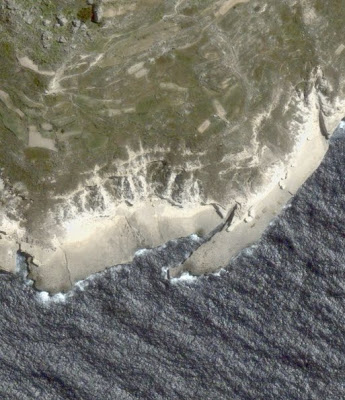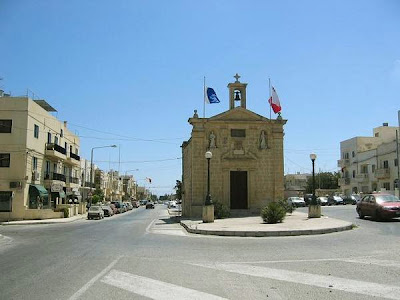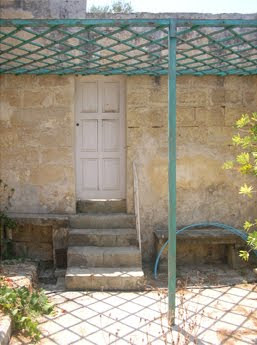
Tuesday, December 29, 2009
Thursday, December 17, 2009
Wednesday, December 16, 2009
Thresholds
 Valletta. shelters. hiding spaces. spying spaces.
Valletta. shelters. hiding spaces. spying spaces.Rabat. the elevated street.
An example of Contemporary Maltese Architecture
There is a little shoe shop in Valletta called 'SHU', designed by Chris Briffa Architects, it is possibly the best example of contemporary architecture bearing a Maltese identity, achieved by mixing inventive new designs with traditional motifs.
The small space is cleverly maximised by turning the whole shop into a series of wooden staircases that act as display, storage and seating. Alongside the sharp wooden staircases traditional wrought iron railings are used. It is a lovely little illustration of what can be done, and a hint of the potential in Maltese architecture that we haven't yet completely uncovered.
Imagine the same intent applied to a bigger scale, with bigger ambitions... What would it be?

 photo credits: www.chrisbriffa.com
photo credits: www.chrisbriffa.com
The small space is cleverly maximised by turning the whole shop into a series of wooden staircases that act as display, storage and seating. Alongside the sharp wooden staircases traditional wrought iron railings are used. It is a lovely little illustration of what can be done, and a hint of the potential in Maltese architecture that we haven't yet completely uncovered.
Imagine the same intent applied to a bigger scale, with bigger ambitions... What would it be?

 photo credits: www.chrisbriffa.com
photo credits: www.chrisbriffa.com
Sunday, December 13, 2009
An Island in the Sea
In a crit it was said that Malta has a very strong identity, that of being an island surrounded by sea. The identity of the rock, the land, that is so recognizable. The fact of having very definite borders, that are not shared with other countries.
These are things that are often taken so for granted.

These are things that are often taken so for granted.

Thursday, December 10, 2009
Monday, December 7, 2009
Friends
1. Henry Coppini
My grandfather, a Maltese retired civil servant and author of “Castille Behind the Scenes”. He was born in 1927, and has lived in Malta for most of his life, including during the Second World War. He is a great source of information on Maltese politics and is also a great story-teller of the Malta he has known.
2. Rebecca Cremona
Maltese émigré and film-maker. Rebecca’s scripts and films are often centred around notions of identity, nostalgia and being Maltese. I intend to use Rebecca as a sounding board for ideas and a source of inspiration.
3. Joran Rapa Manche
Maltese-Londoner and illustrator. I have chosen Joran because he will be able to attend crits, and because he is very opinionated and honest. If the project were to become too personal or unrealistic I am confident that he will point it out.
4. Edward Said
Maltese restoration architect, of the Fondazzjoni Wirt Artna (Malta Heritage Trust) and writer for “The Architect” a Maltese Architectural Publication. Edward knows the workings of Maltese Planning and Architectural practice, he is also a bit of an activist and intends to start a magazine called “Only in Malta”. I think his interests in conservation and his extensive knowledge on Maltese heritage will make for some challenging conversations on the future of Maltese Architecture.
5. Signy Svalstoga
Postgraduate Academic Leader at the ASD, and Diploma Unit 10 tutor. The themes and methodology explored in diploma unit 10 are of interest to me and are relevant to the project, I believe Signy could provide insight into working with varying scales, and exploring notions of memory and tactility.
6. Jon Mitchell
Social Anthropologist whose main research site is Malta. I intend to use him as a sounding board in terms of notions of Maltese identity, to ensure that my observations and assumptions are not too one-sided.
7. Manuel & Anne-Marie Baldacchino of the Limestone Heritage, Malta
I plan to discuss the material; its properties, associated crafts, the processes of extraction and use, its potential for use outside of its traditional function as a block material and the potential of the quarries that are left behiind after its extraction.
8. Maltese Traditional Tile Maker
When in Malta I also plan to meet with a traditional tile-maker to discuss the process of making patterned tiles using different coloured concrete and a metal mould.
9 and 10 Two friends to be identified during the course of the project.
My grandfather, a Maltese retired civil servant and author of “Castille Behind the Scenes”. He was born in 1927, and has lived in Malta for most of his life, including during the Second World War. He is a great source of information on Maltese politics and is also a great story-teller of the Malta he has known.
2. Rebecca Cremona
Maltese émigré and film-maker. Rebecca’s scripts and films are often centred around notions of identity, nostalgia and being Maltese. I intend to use Rebecca as a sounding board for ideas and a source of inspiration.
3. Joran Rapa Manche
Maltese-Londoner and illustrator. I have chosen Joran because he will be able to attend crits, and because he is very opinionated and honest. If the project were to become too personal or unrealistic I am confident that he will point it out.
4. Edward Said
Maltese restoration architect, of the Fondazzjoni Wirt Artna (Malta Heritage Trust) and writer for “The Architect” a Maltese Architectural Publication. Edward knows the workings of Maltese Planning and Architectural practice, he is also a bit of an activist and intends to start a magazine called “Only in Malta”. I think his interests in conservation and his extensive knowledge on Maltese heritage will make for some challenging conversations on the future of Maltese Architecture.
5. Signy Svalstoga
Postgraduate Academic Leader at the ASD, and Diploma Unit 10 tutor. The themes and methodology explored in diploma unit 10 are of interest to me and are relevant to the project, I believe Signy could provide insight into working with varying scales, and exploring notions of memory and tactility.
6. Jon Mitchell
Social Anthropologist whose main research site is Malta. I intend to use him as a sounding board in terms of notions of Maltese identity, to ensure that my observations and assumptions are not too one-sided.
7. Manuel & Anne-Marie Baldacchino of the Limestone Heritage, Malta
I plan to discuss the material; its properties, associated crafts, the processes of extraction and use, its potential for use outside of its traditional function as a block material and the potential of the quarries that are left behiind after its extraction.
8. Maltese Traditional Tile Maker
When in Malta I also plan to meet with a traditional tile-maker to discuss the process of making patterned tiles using different coloured concrete and a metal mould.
9 and 10 Two friends to be identified during the course of the project.
Approach
1. Memories and nostalgias of Malta will be recorded as a starting point to the project. This stage must be completed before returning to Malta in December, and before getting too absorbed in the project.
2. Research into traditional materials, crafts and building techniques.
Limestone; its material properties, the ways in which it could be adapted and the quarries that its extraction leaves behind will be studied. Traditional tile making techniques will also be researched.
3. Observations on Maltese identity and architecture will be recorded and made public on a Blog and by publication in a Maltese magazine, with the aim of getting feedback which will inform the project.
4. The memories, research, observations and feedback will inform design proposals, in varying scales, of several public spaces. These might incorporate some or all of the following; a promenade, swimming lido, public toilets, park, boat houses,...
5. Finally the project will be concluded through a public forum or exhibition.
2. Research into traditional materials, crafts and building techniques.
Limestone; its material properties, the ways in which it could be adapted and the quarries that its extraction leaves behind will be studied. Traditional tile making techniques will also be researched.
3. Observations on Maltese identity and architecture will be recorded and made public on a Blog and by publication in a Maltese magazine, with the aim of getting feedback which will inform the project.
4. The memories, research, observations and feedback will inform design proposals, in varying scales, of several public spaces. These might incorporate some or all of the following; a promenade, swimming lido, public toilets, park, boat houses,...
5. Finally the project will be concluded through a public forum or exhibition.
Sites
The coast will be of significance as the place of respite from the crowded island, the boundary between the island and the rest of the world, and the point where isolation is most felt.
A need for public space
Malta has a very high population density, and in addition the Maltese family has an average of 4 cars. These two factors result in the country being very crowded.
Town planning tends to cater for vehicles before people. This has resulted in places with great potential for public space, like church squares, being taken up by parked cars and roads, leaving little space for people and public outdoor activities.

As previously mentioned the coast is the perfect place to find respite from the crowded country. Yet this precious resource has been reduced and cut off by the roads that run alongside it.
The program will aim to address these issues through the design of space for community activities, for everyday life, for public expression of Malteseness, whatever that may be.
Town planning tends to cater for vehicles before people. This has resulted in places with great potential for public space, like church squares, being taken up by parked cars and roads, leaving little space for people and public outdoor activities.

As previously mentioned the coast is the perfect place to find respite from the crowded country. Yet this precious resource has been reduced and cut off by the roads that run alongside it.
The program will aim to address these issues through the design of space for community activities, for everyday life, for public expression of Malteseness, whatever that may be.
Labels:
cars,
crowded,
population density,
public space,
town planning
The role of Nostalgia*

Following on from my position as a Maltese emigre, nostalgia inevitably comes into play.
I aim to make use of my own nostalgia to identify Maltese idiosyncrasies that I consider important, that are often taken for granted by locals, to point out the uniqueness of our culture, and the hidden beauty found in unexpected places.
Note: I do not want the project to become overly personal. It should be relevant to all Maltese people. For it to be successful it should tap into a common nostalgia, and not simply my own.
*The term nostalgia describes a longing for the past, often in idealized form. The word is a learned formation of a Greek compound, consisting of nóstos, “returning home” and álgos, “pain” or “ache”.
My role as a Maltese émigré*

As a Maltese émigré I am different from other Maltese people: I have left the island and chosen not to return, as a consequence my experience of Malta is different to that of other Maltese.
1. I have a very clear idea of what I miss, of what makes me homesick when I am away.
2. On my return I am able to compare my memories with the reality I am faced with, and in doing so I notice change.
3. I am able to compare the state of the country with that of my new ‘home’.
My relationship with Malta is one of homesickness and frustration, a result of the differences between memory and reality.
Note: I wish to be cautious about being yet another colonizer, who arrives and assumes they know better than the locals.
*I refer to myself as an émigré, this is a French term that refers to a person who has “migrated out,” it often carries connotations of politico-social self-exile.
In search of a Maltese Architectural Language
My starting point is to investigate notions of Maltese identity; an identity that resembles numerous cultures and so is full of contradictions, bearing in mind that it is the sum of these contradictions that make Malta unique.
By gaining a better understanding of Maltese identity, through research, observation, exposure of ideas, debate and feedback, I hope to strengthen notions of identity* - both my own, and those of the Maltese as a group - and in doing so to initiate a discussion and development of a Maltese architectural language.

*To strengthen one’s sense of identity need not imply preserving oneself, or protecting oneself from outside influence. It is the contrary; if one is confident and secure in their identity then they need not feel threatened by anything considered “different”. They are able to build on that sense of identity, adapt to changing circumstances, unafraid of losing it. This project does not intend to promote the preservation of Malta or Maltese identity, the focus will be on learning from the past to develop the new, whilst acknowledging that change is inevitable.
By gaining a better understanding of Maltese identity, through research, observation, exposure of ideas, debate and feedback, I hope to strengthen notions of identity* - both my own, and those of the Maltese as a group - and in doing so to initiate a discussion and development of a Maltese architectural language.
*To strengthen one’s sense of identity need not imply preserving oneself, or protecting oneself from outside influence. It is the contrary; if one is confident and secure in their identity then they need not feel threatened by anything considered “different”. They are able to build on that sense of identity, adapt to changing circumstances, unafraid of losing it. This project does not intend to promote the preservation of Malta or Maltese identity, the focus will be on learning from the past to develop the new, whilst acknowledging that change is inevitable.
Maltese Architecture
Malta’s colonial past has left it with a rich and varied architectural heritage, inherited from its colonisers and therefore not really designed by or for the Maltese. It seems like something is missing in today’s Maltese architecture.
The uniqueness that exists in our landscape, food, stories, language, habits and superstitions doesn’t seem to exist in our architecture.
A Fragmented Identity
National identity has been an object of political debate in Malta since the first very polarized political parties were formed; first on the issues of language, then questions on relations with Britain, Europe, North Africa and more recently, on relations with the European Union.
This notion of being associated with one larger nation has resulted in fragmented and polarised ideas of what Maltese identity is.
Isolation, density and the sea
The island* is so small that the sea’s presence is always felt, it is the only respite in such an overcrowded country, where everybody knows everybody.
Yet at the same time, being able to look out in all directions, to see the edges of the land, to watch the weather approaching and passing over the island make one feel very small and isolated, like a boat out at sea, forgotten by the rest of the world.
*Malta is an archipelago; Malta, Gozo and Comino being the 3 larger, inhabited islands. This project will focus on Malta, the largest island, because Gozo is more preserved and unbuilt and Comino is virtually untouched.
Introduction to Malta
 Image of the Maltese Archipelago as it appears on a world map - the star that marks the capital city almost covers the whole island.
Image of the Maltese Archipelago as it appears on a world map - the star that marks the capital city almost covers the whole island.Capital: Valletta
Area: 316 km2
Population: 413,609
Population Density: 1,298/km2 (6th)
Sicily: 93km North
Tunisia: 288km West
Religion: 98% Roman Catholic
Independence from the UK: 21 September 1964
EU Accession: 1 May 2004
Official Languages: Maltese, English
Ethnic Groups: Maltese 95.3%, British 1.6%, other 3.1%
Malta is a tiny island of seemingly insignificant size, unknown to most of the world, yet it was once fought over because of its strategic position at the centre of the Mediterranean. This resulted in its being colonised by numerous empires: Carthaginians, Romans, Arabs, Normans, Sicilians, Knights of St.John, French and British, each leaving its own mark on the islands and their people.
‘Sunny Malta’ is mostly known as a cheap, English-speaking package-holiday destination yet less known is that it is the 6th most densely populated country in the world and home to the world’s oldest freestanding structures.
Ninety-eight percent of the population is Roman Catholic (thanks to St.Paul for famously being shipwrecked on the island), making the nation one of the most Catholic countries in the world, yet they praise ‘Alla’ meaning God in Maltese - which is an Arabic dialect, the only official language of the EU that is defined as semitic and the only semitic language that is written in the latin alphabet. Maltese and English were recognised as official languages when they replaced Italian in 1934, making for a bilingual country in which 86% of the population prefer to speak Maltese, 12% English, and 2% Italian.
Labels:
Alla,
Britain,
colonisation,
EU,
Italian,
Malta,
Maltese,
Mediterranean,
package-holiday,
Roman Catholic,
semitic,
Sicily,
Tunisia,
Valletta
Subscribe to:
Posts (Atom)














